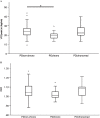Chronotropic Incompetence During Exercise Testing as a Marker of Autonomic Dysfunction in Individuals with Early Parkinson's Disease
- PMID: 38189712
- PMCID: PMC10836543
- DOI: 10.3233/JPD-230006
Chronotropic Incompetence During Exercise Testing as a Marker of Autonomic Dysfunction in Individuals with Early Parkinson's Disease
Abstract
Background: An attenuated heart rate response to exercise, termed chronotropic incompetence, has been reported in Parkinson's disease (PD). Chronotropic incompetence may be a marker of autonomic dysfunction and a cause of exercise intolerance in early stages of PD.
Objective: To investigate the relationship between chronotropic incompetence, orthostatic blood pressure change (supine - standing), and exercise performance (maximal oxygen consumption, VO2peak) in individuals with early PD within 5 years of diagnosis not on dopaminergic medications.
Methods: We performed secondary analyses of heart rate and blood pressure data from the Study in Parkinson's Disease of Exercise (SPARX).
Results: 128 individuals were enrolled into SPARX (63.7±9.3 years; 57.0% male, 0.4 years since diagnosis [median]). 103 individuals were not taking chronotropic medications, of which 90 had a normal maximal heart rate response to exercise testing (155.3±14.0 bpm; PDnon-chrono) and 13 showed evidence of chronotropic incompetence (121.3±11.3 bpm; PDchrono, p < 0.05). PDchrono had decreased VO2peak compared to PDnon-chrono (19.7±4.5 mL/kg/min and 24.3±5.8 mL/kg/min, respectively, p = 0.027). There was a positive correlation between peak heart rate during exercise and the change in systolic blood pressure from supine to standing (r = 0.365, p < 0.001).
Conclusions: A subgroup of individuals with early PD not on dopaminergic medication had chronotropic incompetence and decreased VO2peak, which may be related to autonomic dysfunction. Evaluation of both heart rate responses to incremental exercise and orthostatic vital signs may serve as biomarkers of early autonomic impairment and guide treatment. Further studies should investigate whether cardiovascular autonomic dysfunction affects the ability to exercise and whether exercise training improves autonomic dysfunction.
Keywords: Exercise; Parkinson’s disease; autonomic nervous system; chronotropic incompetence; heart rate.
Conflict of interest statement
The authors have no conflict of interest to report.
Figures




References
-
- Kalia LV, Lang AE (2015) Parkinson’s disease. Lancet 386, 896–912. - PubMed
-
- Coon EA (2020) Autonomic dysfunction in the synucleinopathies. Semin Neurol 40, 492–501. - PubMed
-
- Merola A, Romagnolo A, Rosso M, Suri R, Berndt Z, Maule S, Lopiano L, Espay A (2018) Autonomic dysfunction in Parkinson’s disease: A prospective cohort study. Mov Disord 33, 391–397. - PubMed
Publication types
MeSH terms
Grants and funding
LinkOut - more resources
Full Text Sources
Medical

